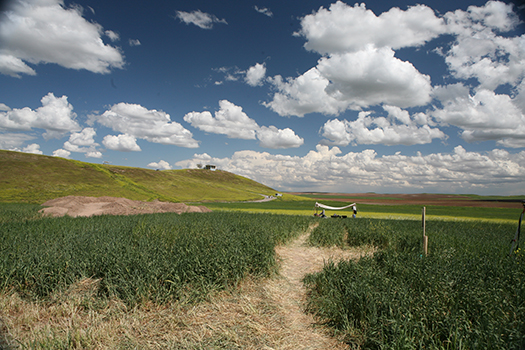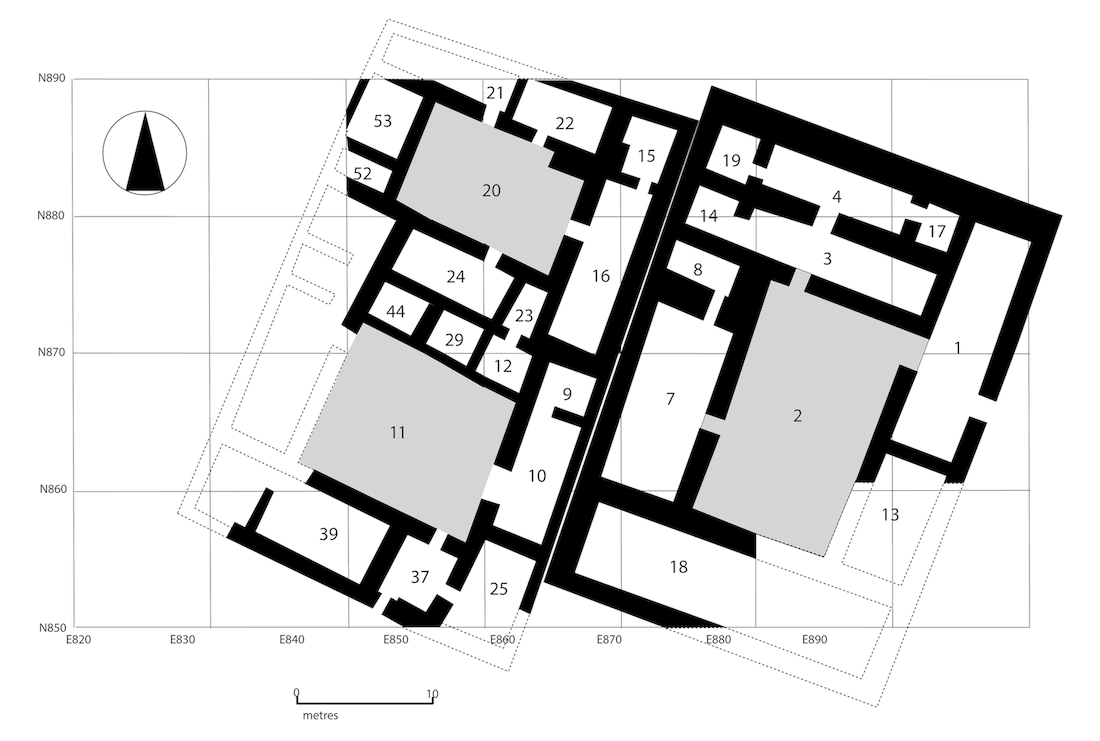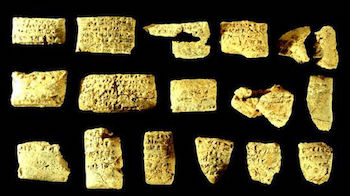You are seeing an unstyled version of this site. If this is because you are using an older web browser, we recommend that you upgrade to a modern, standards-compliant browser such as FireFox [http://www.getfirefox.com/], which is available free of charge for Windows, Mac and Linux.
Neo-Assyrian Archival Texts from Tušhan

The mound of Ziyaret Tepe (ancient Tušhan). Photo credit: Hilary McDonald
The ancient city of Tušhan is located on the upper reaches of the Tigris and has been identified with the archaeological site of Ziyaret Tepe in south-eastern Turkey due to cuneiform texts excavated there and at nearby Giricano, which mention the city by name. From the 9th century BC onwards, Tušhan served as a provincial capital of the Assyrian Empire. It was situated right on the northern edge of the empire's directly administered territories, until further expansion in the early 7th century BC shifted the border northwards. Rich evidence for this phase of the city's long existence was brought to light by the excavations of an international team led by Timothy Matney (University of Akron), Kemalettin Köroǧlu (Marmara University), John McGinnis (University of Cambridge), and Dirk Wicke (Goethe University Frankfurt) from 1997–2014.
Textual sources from the city of Mari on the Euphrates attest that in the early second millennium BC, the city belonged to the small local kingdom of Eluhut. Later, it became part of Mittani, and when that major power collapsed in the 13th century BC, the city was brought under Assyrian control. In the course of the 11th century BC, Aramean incursions weakened that hold and the territory was lost. Tušhan and its region were brought back into the kingdom of Assyria only in 882 BC, at the very beginning of the reign of Ashurnasirpal II [/riao/theassyrianempire883745bc/ashurnasirpalii/index.html]. According to his inscriptions, the city's Assyrian inhabitants had previously fled to the land of Šubria (i.e., the mountain region north of the Tigris) and were now resettled in Tušhan, where new city fortifications, a palace and grain storage facilities were constructed. Thereafter, the city served as an Assyrian provincial capital until 611 BC. At that time, it was conquered by the troops of Nabopolassar [/ribo/babylon7/rulers/nabopolassar/index.html] of Babylon (r. 625–505 BC), after he had achieved a resounding victory with his Median allies over the Assyrian Empire's forces at Nineveh in 612 BC.
Archaeological evidence attests to Ziyaret Tepe's occupation from the Early Bronze Age through to the Ottoman period. During the Neo-Assyrian period, the site reached its largest extent. At this time, it took up around thirty hectares and consisted of a very substantial lower town and a citadel that rises twenty-two meters above the surrounding river valley. This citadel housed the palace where the governor of Tušhan resided as the representative of the king of Assyria. The lower town with its residential and economic buildings was protected by an impressive city wall. Although evidence for the site's earlier Assyrian occupation has been detected on the citadel very little survives of it due to the subsequent Neo-Assyrian building activity. It is noteworthy that Tiglath-pileser III [/saao/aebp/essentials/kings/tiglatpileseriii/index.html] (r. 744–727 BC) records settling population groups from elsewhere in the empire in Tušhan in his annals [/rinap/Q006333], thereby further adding to the city's already sizable population. However, after the Babylonian forces conquered the city in 611 BC, Tušhan never fully recovered. Subsequent habitation was scattered throughout the lower town and citadel, and the city never again reached its previous size. Today, the site lies in agricultural land.

The plan of the two buildings in Operation G/R, where most of the tablets were found in Building II (left) rooms 9-10.
So far, only texts from the Neo-Assyrian period were brought to light at Ziyaret Tepe. The vast majority of the cuneiform tablets found at the site were excavated as part of one group of texts, which was recovered in a large building in Operation G/R in the lower town, spread over two rooms off its central courtyard. As many weights, tokens, and sealings were found alongside the tablets, this building seems to have served economic purposes. One possible interpretation is that the building was a central storage depot servicing the entire city. Many of these cuneiform tablets recorded basic administrative transactions, mostly concerning barley [/atae/tuszhan/P481176], but other commodities were also recorded (e.g. copper [/atae/tuszhan/P481186] and sheep [/atae/tuszhan/P509070]). One text, however, stands out from the rest of the documents in this group:

A selection of clay tablets with Neo-Assyrian texts discovered at Ziyaret Tepe. From Ziyaret Tepe [https://umanitoba.ca/colleges/st_pauls/nebal/762.html] home page of St. Pauls College of the University of Manitoba.
- ZTT 22 [/atae/tuszhan/P481183] is a remarkably evocative letter written by Mannu-kī-Libbāli to (presumably) the treasurer (the title is very poorly preserved but this is the only possible reading) that dates to the very end of the Assyrian Empire's control over the city. The writer details the collapse of the military and administrative structures around him and bemoans the fact that he cannot raise sufficient troops and armaments to defend the city. He closes his letter with the words: "Death will come out of it! No one [will escape]. I am done!"
Three further clay tablets were found in the palace on the citadel of Tušhan. One is a list of textiles, the other two documents are lists of female names. One of these is of great interest:
- ZTT 30 [/atae/tuszhan/P509068] lists women at the disposal of various villages in the countryside around Tušhan, and many of their names are from unknown languages, attesting perhaps to the Assyrian Empire's well documented policy of mass resettlement.
Beyond epigraphic evidence, the site has also contributed to our understanding of literacy and numeracy within the cuneiform world. Together with the cuneiform tablets found in the large building in the lower town, a sizable group of clay tokens was discovered. These objects constitute short-term administrative tools that were used for accounting purposes, and their presence amidst the cuneiform documentation attests to their role in producing longer-term written records. It was possible to identify a core set of tokens that was used across northern Mesopotamia, suggesting that a standard inventory of token shapes was used by the Neo-Assyrian administration. For more information see:
- John MacGinnis, et al., "Artefacts of Cognition: The Use of Clay Tokens in a Neo-Assyrian Provincial Administration," [https://doi.org/10.1017/S0959774314000432 ] Cambridge Archaeological Journal 24 (2014), 289–306.
- M. Willis Monroe, "Tokens and Tablets: Administrative Practice on the Edge of the Empire – the Evidence from Ziyaret Tepe (Tušhan)," The Provincial Archaeology of the Assyrian Empire, edited by John MacGinnis et al., McDonald Institute for Archaeological Research, 41–48.
Reports on the site can be found in the journal Anatolica [https://poj.peeters-leuven.be/content.php?url=journal&journal_code=ANA] (1998–2015). A well illustrated overview of the site is published as Timothy Matney, John MacGinnis, Dirk Wicke, and Kemalettin Köroğlu, Ziyaret Tepe: Exploring the Anatolian frontier of the Assyrian Empire [http://www.archaeopress.com/ArchaeopressShop/Public/displayProductDetail.asp?id=%7BFA776FAA-4349-41C8-A2FC-C8107AF8C318%7D] (ArchaeoPress 2017).
A working bibliography for the site can be found at this public Zotero group [https://www.zotero.org/groups/2842547/ziyaret_tepe].
This sub-project of the Archival Texts of the Assyrian Empire (ATAE) [/atae/index.html] Project includes open-access, annotated (lemmatized) versions of all of the published Neo-Assyrian texts from Tušhan. At present, thirty-three such texts have been discovered and published in the following scholarly journals:
- Simo Parpola, "Cuneiform texts from Ziyaret Tepe (Tušḫan), 2002–2003," State Archives of Assyria Bulletin 17 (2008), 1–113
- John MacGinnis, "Evidence for a Peripheral Language in a Neo-Assyrian Tablet from the Governor's Palace in Tuşhan," [https://www.jstor.org/stable/10.1086/664450] Journal of Near Eastern Studies 71 (2012), 13–20
- John MacGinnis and Willis Monroe, "Recent Texts from Ziyaret Tepe," [https://www.academia.edu/12103559/Recent_Texts_from_Ziyaret_Tepe] State Archives of Assyria Bulletin 20 (2013–14), 47–56
The editions presented on ATAE/Tušhan have been adapted and lemmatized from the source publications by M. Willis Monroe, Jamie Novotny, and Poppy Tushingham.
Click here [/atae/tuszhan/pager] to browse the Tušhan corpus.
ATAE is a key component of the Archival Texts of the Middle East in Antiquity (ATMEA) sub-project of the LMU-Munich-based Munich Open-access Cuneiform Corpus Initiative [https://www.en.ag.geschichte.uni-muenchen.de/research/mocci/index.html] (MOCCI; directed by Karen Radner and Jamie Novotny). Funding for the ATAE corpus project has been provided by LMU Munich and the Alexander von Humboldt Foundation (through the establishment of the Alexander von Humboldt Chair for Ancient History of the Near and Middle East).
For further details, see the "About the project" [/atae/abouttheproject/index.html] page.

M. Willis Monroe & Karen Radner
M. Willis Monroe & Karen Radner, 'Neo-Assyrian Archival Texts from Tušhan', Neo-Assyrian Archival Texts from Tušhan, The ATAE/Tušhan Project, a sub-project of MOCCI, 2023 [http://oracc.org/atae/tuszhan/]